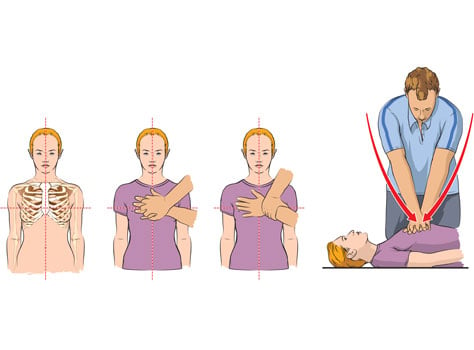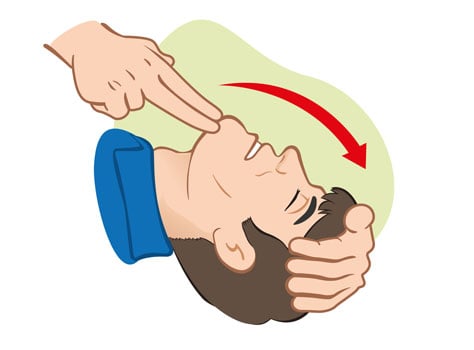In our last article Why CPR helps to save lives I discussed the reasons why Cardiac Pulmonary Resuscitation can be the only way to save a person’s live. In this article I will try to explain how you actually perform CPR.
It is highly recommended to take an accredited course for CPR and AED training at least every 1-2 years. Motor skills are best learned by practice: the best way to really remember how to perform CPR is to do it! You will learn where, how hard, and how fast to push for chest compressions. You will learn how to open an airway or provide rescue breaths. CPR doesn’t need to be intimidating once you have the opportunity to practice and get feedback from an instructor. Becoming CPR and AED certified gives you the skills and confidence you need to be an effective emergency responder.
First, take a breath and stay calm
When faced with a medical emergency, it is difficult not to panic, even if you’ve had training. Considering that 88% of cardiac arrest cases occur at home, you are most likely to use CPR on a family member or loved one. This can cause many people to make mistakes or ‘freeze up.’ The best way to overcome this instinct is to first stop whatever it is that you are doing. Think about what you have been trained to do through a class or even remember the information in this article. Assess the area to make sure the environment is safe for you to assist. Take a deep breath, and then act.
If you see someone suddenly collapse or come across someone who appears unconscious, gently shake and tap them, asking “Are you okay?” If the person is unresponsive, unconscious and not breathing or gasping for breath, they need CPR. Before beginning CPR, make sure that emergency medical services are alerted and an ambulance is sent to your location. In Thailand, you should call 1669 or the nearest hospital’s Emergency Room number. If there is an AED available, deliver one shock first before beginning CPR.
An easy acronym for remembering what to do in CPR is C-A-B:
C - Chest Compressions
A - Open the Airway
B - Rescue Breaths
Chest compressions
- Place the person on his or her back on a hard surface (not a mattress!)
- Position yourself on your knees next to the patient’s shoulders.
- Place the heel of one hand directly in the center of the chest between the nipples. Place your other hand on top, interlacing the fingers.
- Keeping your elbows straight, and using your body weight to help, push down hard and fast: at least 2 inches (5 centimeters) and at a rate of 100 compressions per minute. This is the same beat as the popular song, “Stayin Alive” by the Bee Gees.
- Perform 30 chest compressions. If you are untrained or prefer to perform compression-only CPR, continue to provide chest compressions until emergency medical services arrive at a rate of 100 compressions per minute.

Open the Airway
- Open the airway using the head-tilt, chin lift method: Using the palm of one hand, gently tilt the head back while using the other hand to lift the chin to open the person’s airway.

Rescue Breaths
- If you have a face shield, place the shield over the person’s mouth. With the airway open, pinch the nose and cover the mouth of the person with your mouth.
- Provide 2 rescue breaths lasting approximately 1 second each. You should see the chest rise while giving a rescue breath. If you don’t see the chest rise after the first breath, try to open the person’s airway again. Do not try more than 2 times to provide rescue breaths, even if you don’t see the chest rise.
- Continue again with 30 chest compressions and 2 rescue breaths for 5 cycles and then reassess the patient for breathing. If the patient is still not breathing normally, continue performing CPR until the patient revives, emergency medical services arrive, or you are too exhausted to continue.
Compression-only CPR is where the rescuer provides continuous chest compressions at a rate of 100 compressions per minute. This technique still allows blood to circulate and is most appropriate for untrained bystanders or for rescuers who do not feel comfortable in providing rescue breaths.
Reading this blog is a good way to get a basic understanding of what CPR is and how it works. A medical emergency can happen anywhere, at any time, and to anyone so it is so important to know what do to avoid an unnecessary death. Because stepping in to help can double or triple a person’s chance of survival, learning CPR is certainly a valuable skill to learn.
We hope this article has helped explain why CPR helps to save lives. If you have any questions you can add a comment in the form below.
By Laurie Coyler –Charusorn, Emergency First Response Instructor and Business Unit Director, and Dr. Preecha Laohakunakorn, Pediatric Cardiologist at the Children Center, Bumrungrad Hospital
For more information please contact:
Last modify: April 21, 2025